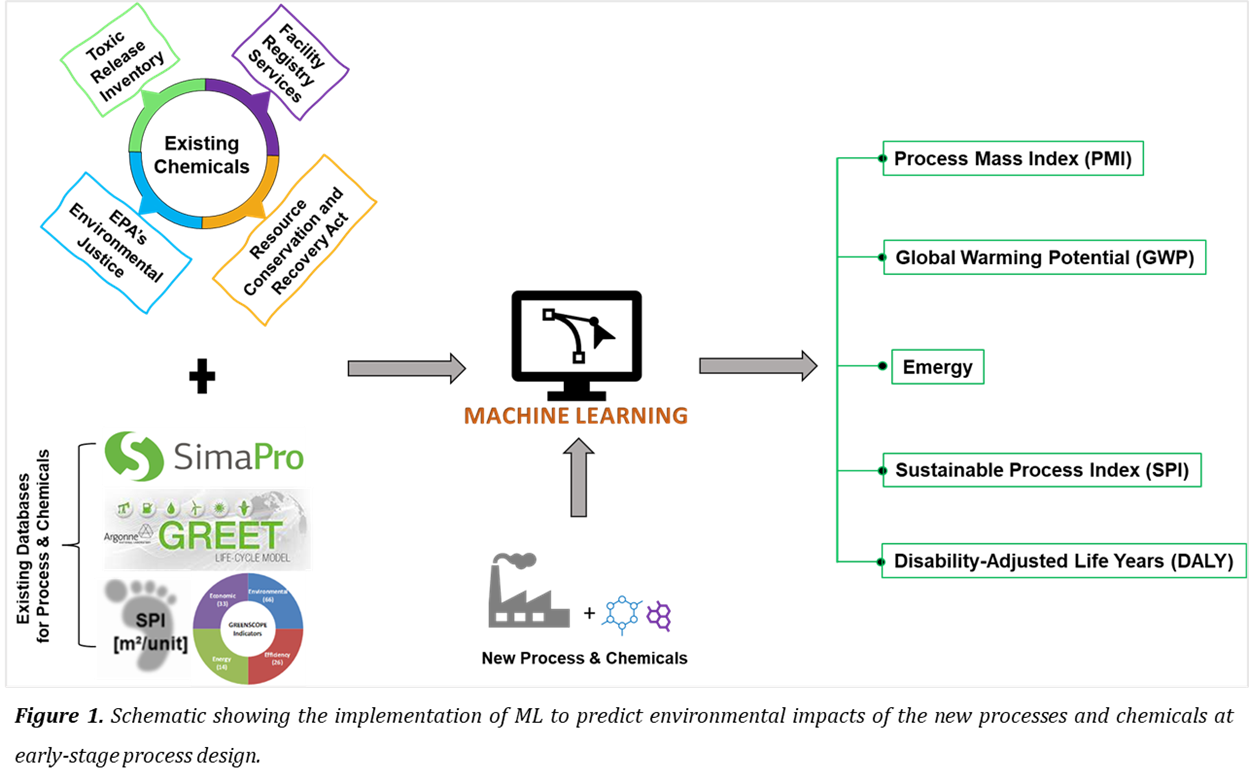(83c) Estimating Environmental Impacts at Early-Stage Process Synthesis Using Machine Learning Approach
AIChE Annual Meeting
2022
2022 Annual Meeting
Process Development Division
Environmentally Friendly Product and Process Development for Sustainability
Monday, November 14, 2022 - 8:50am to 9:15am
To that end, we present in this work, a ML approach to estimating the environmental pressures of early-stage process networks. In this work, we collect data on chemicals , material flows, environmental releases, and emissions to air, ground and water bodies from databases and repositories such as the EPA TRI (Toxic Release Inventory) Explorer, FRS (Facility Registry Services), RCRA (Resource Conservation and Recovery Act), and the NREL US Life Cycle Inventory Database (“Release Chemical Report | TRI Explorer | US EPA,†n.d.; US EPA, 2015). From these available datasets, we identify the physicochemical and structural properties such as functional groups, molecular weights, number of atoms, H/C ratios, bond strengths, toxicity, health and exposure impacts of these chemicals. Since environmental impacts are ultimately linked to mass and energy flows of a product, thermodynamic properties add additional information when combined with these molecular descriptors. Hence in this analysis we further consider these thermodynamic properties to increase the accuracy of the predictions. Next, we collect targeted process-related emissions and sustainability metrics data via LCA tools such as GREET (Greenhouse Gases, Regulated Emissions, and Energy Use in Technologies) model by Argonne National Lab, SIMAPRO® and its Ecoinvent database, SPIonWeb, GREENSCOPE. The datasets from these tools are used in conjunction with the datasets from the chemical releases databases and repositories to predict new chemical and process metrics including Process Mass Index (PMI), CO2 emissions, Global Warming Potential, Emergy, Disability-Adjusted Lifetime Years (DALY), and Sustainable Process Index (SPI) (Brown et al., 2012; Goedkoop and Spriensma, 2001; Narodoslawsky, 2015; Shahzad et al., 2014; Smith et al., 2019). This predictive correlation is achieved using multi-regression ML algorithms. In our analysis, the functional unit is 1 kg of product chemical. Figure 1 shows the schematic of this approach.
References
Brown, M.T., Raugei, M., Ulgiati, S., 2012. On boundaries and ‘investments’ in Emergy Synthesis and LCA: A case study on thermal vs. photovoltaic electricity. Ecological Indicators 15, 227–235. https://doi.org/10.1016/j.ecolind.2011.09.021
Calvo-Serrano, R., González-Miquel, M., Papadokonstantakis, S., Guillén Gosálbez, G., 2017. Cradle-to-gate environmental impact prediction from chemical attributes using mixed-integer programming, in: Computer Aided Chemical Engineering. Elsevier, pp. 1999–2004. https://doi.org/10.1016/B978-0-444-63965-3.50335-4
Calvo-Serrano, R., González-Miquel, M., Papadokonstantakis, S., Guillén-Gosálbez, G., 2018. Predicting the cradle-to-gate environmental impact of chemicals from molecular descriptors and thermodynamic properties via mixed-integer programming. Computers & Chemical Engineering 108, 179–193. https://doi.org/10.1016/j.compchemeng.2017.09.010
Goedkoop, M., Spriensma, R., 2001. The Eco-indicator 99 A damage oriented method for Life Cycle Impact Assessment. Annex report Eco-indicator 99 87.
Karka, P., Papadokonstantakis, S., Kokossis, A., 2019a. Environmental impact assessment of biomass process chains at early design stages using decision trees. Int J Life Cycle Assess 26.
Karka, P., Papadokonstantakis, S., Kokossis, A., 2019b. Predictive LCA - a systems approach to integrate LCA decisions ahead of design, in: Computer Aided Chemical Engineering. Elsevier, pp. 97–102. https://doi.org/10.1016/B978-0-12-818634-3.50017-5
Narodoslawsky, M., 2015. Chapter 3 - Sustainable process index, in: Klemeš, J.J. (Ed.), Assessing and Measuring Environmental Impact and Sustainability. Butterworth-Heinemann, Oxford, pp. 73–86. https://doi.org/10.1016/B978-0-12-799968-5.00003-8
Papadokonstantakis, S., Karka, P., Kikuchi, Y., Kokossis, A., 2016. Challenges for Model-Based Life Cycle Inventories and Impact Assessment in Early to Basic Process Design Stages, in: Sustainability in the Design, Synthesis and Analysis of Chemical Engineering Processes. Elsevier, pp. 295–326. https://doi.org/10.1016/B978-0-12-802032-6.00013-X
Release Chemical Report | TRI Explorer | US EPA [WWW Document], n.d. URL https://enviro.epa.gov/triexplorer/tri_release.chemical (accessed 4.11.22).
Shahzad, K., Kollmann, R., Maier, S., Narodoslawsky, M., 2014. SPIonWEB – Ecological Process Evaluation with the Sustainable Process Index (SPI), in: Computer Aided Chemical Engineering. Elsevier, pp. 487–492. https://doi.org/10.1016/B978-0-444-63456-6.50082-X
Smith, R.L., Tan, E.C.D., Ruiz-Mercado, G.J., 2019. Applying Environmental Release Inventories and Indicators to the Evaluation of Chemical Manufacturing Processes in Early Stage Development. ACS Sustainable Chem. Eng. 7, 10937–10950. https://doi.org/10.1021/acssuschemeng.9b01961
US EPA, O., 2015. History of the Resource Conservation and Recovery Act (RCRA) [WWW Document]. US EPA. URL https://www.epa.gov/rcra/history-resource-conservation-and-recovery-act-... (accessed 5.11.21).
